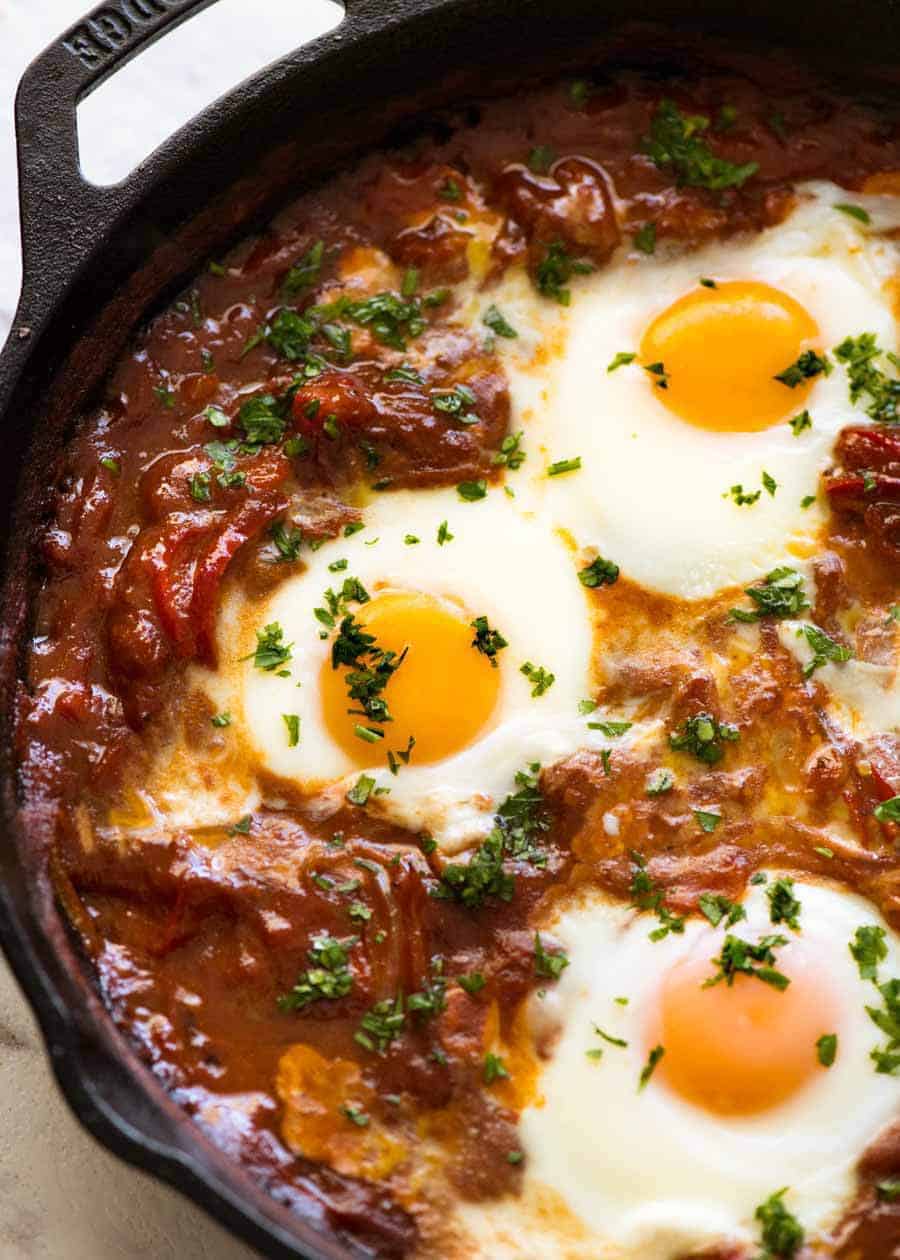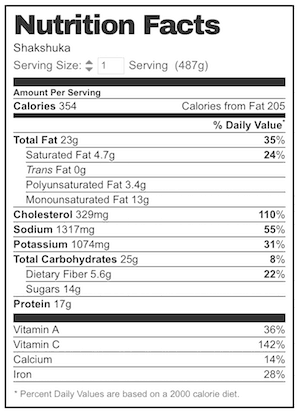SHAKSHUKA (MIDDLE EASTERN BAKED EGGS)
The best baked eggs in the world – Shakshuka! A Middle Eastern and North African dish traditionally served up for breakfast or lunch, this can be made entirely on the stove or finished in the oven. However, bread for dunking/mopping is not optional!







I’ll let you in on a trade secret – usually, the photos you see of so called baked eggs aren’t really baked at all. When eggs are baked, the thin film of egg whites covering the yolks becomes opaque, fogging up the beautiful bright yellow yolks.
“This is a catastrophe!” said some food magazine editor, somewhere. “We cannot have foggy yolks! They must be bright yellow. This must be fixed!” (I hear this in my head with a French accent, but I don’t know why)
And so some food stylist or food preparation person scuttled off, and came back with a solution now adopted by food stylists everywhere: pan fry the eggs sunny side up then slide them into whatever sauce or vehicle they were supposedly baked in.
It’s always obvious when this is done because you don’t get the messy bleed of whites mixed in with the sauce, like you see in these photos.
So yes, I sacrificed glaringly yellow yolks to make this the way the recipe is written. I did cheat a bit though- I carefully wiped off as much of the egg whites from the yolks before baking them.
I assure you I do not do that in real life.

Now that I’ve changed the way you’ll look at baked eggs photos forever, let’s talk about the world’s best baked eggs – Shakshuka.
WHAT IS SHAKSHUKA?
It’s basically eggs that are baked or poached in a fragrant tomato sauce, usually with capsicum (bell peppers), onion and spices like cumin and paprika, reflecting the Middle Eastern and North African roots of this dish.
Though traditionally thought of as a breakfast or brunch recipe, I’m forever on my “eggs anytime of the day” crusade and I’m sitting here at 5.18pm on Wednesday 25 July 2018, wondering what to have for dinner tonight and I just decided to make this (again).

BRILLIANT FOR CAMPING – AND MAKING IN BULK
Though I call Shakshuka a type of baked eggs, ironically my favourite way of making it is over campfire, poaching rather than baking. One of my best friends had a remote wild-river wedding and the outdoor caterers they hired made Shakshuka for 80 wedding guests over campfire.
It worked brilliantly because eggs take mere minutes to cook, so they made large pots of this fragrant tomato sauce then cooked dozens and dozens of eggs in them. Poach, serve, then repeat in the same pots.


Shakshuka (Middle Eastern Poached or Baked Eggs)
Prep Time
10 mins
Cook Time
20 mins
Total Time
30 mins
Recipe video above. I call this the best baked eggs in the world, but they can also just be poached on the stove! With Middle Eastern and North African roots, the tomato sauce is lightly spiced and used as the bed to cook the eggs. PS Crusty bread is a must. PPS Recipe lends itself to great variations - see recipe notes.
Course: Breakfast
Cuisine: Israeli, Middle Eastern, North African
Keyword: Shakshuka
Calories: 354 kcal
Ingredients
- 2 tbsp olive oil
- 1 small red onion , peeled, halved and sliced
- 1 garlic clove , minced
- 1 small red capsicum (bell pepper) , halved lengthways and sliced into 0.5cm/1/4” strips
- 1 tomato , diced
- 400 g / 14 oz can crushed tomatoes
- 1 tbsp tomato paste
- 1/2 cup / 125 ml chicken or vegetable broth (or water)
- 1 tsp EACH paprika and cumin
- 1/4 tsp EACH black pepper and cayenne pepper (or other hot spice, adjust to taste)
- 1/2 tsp salt
- 4 eggs eggs (up to 6 eggs ok)
- 2 tbsp fresh parsley or coriander / cilantro , roughly chopped
- Pita or crusty bread, to serve
Instructions
- Preheat oven to 180C/350F (if intending to bake them).
- Heat oil in a medium size cast iron skillet over medium high heat. Add garlic and onion, cook for 2 minutes until onion is translucent.
- Add capsicum, cook for 1 minute. Add diced tomato, cook for 2 minutes until broken down and it becomes a bit pasty (see video).
- Add canned tomatoes, tomato paste, broth, paprika, cumin, salt and pepper. Mix to combine well.
- Lower stove to medium low and simmer for 5 minutes until just thickened enough to make indentations (don't want dry sludge, needs to still be saucy).
- Make indentations in the mixture and carefully crack the eggs in. Leave to cook for 1 minute until edges of whites are set (Note 1).
- Transfer to oven and bake for 7 to 12 minutes until whites are just set but yolks are still runny (or to your taste). OR cover with lid and steam on stove for 3 minutes (runny yolks), or just simmer them without a lid.
- Remove from oven/stove and serve immediately, scattered with the coriander or parsley. Serve with crusty bread, or pita bread.
Recipe Notes
1. Baking eggs perfectly so you get runny yolks but the whites are just set rather than jelly-like (ie still a teeny bit raw) is actually a bit of an art. My way of getting around this is to leave the eggs to cook in the mixture for 1 minute before transferring to the oven. This gives the whites a bit of a head start without affecting the yolks.
2. Variations - this recipe lends itself to a great many variations. Try substituting the capsicum with other vegetables such as zucchini (courgettes), eggplants (aubergines), or even carrots or fennel. For a baked beans-ish spin (that's breakfast baked beans, as Aussies and Poms know them, not American baked beans), try adding white beans. Try adding olives, or other antipasto-ey things (artichokes, sun dried tomatoes). For a Mexican spin, use corn and black beans!
3. This recipe as written makes 2 very generous servings (2 eggs per person) (this is what the nutrition reflects). But there's enough sauce here for 3 servings if you can squeeze 6 eggs in. I opted to just use 4 here so you can actually see the sauce in the photos and video.

MORE RECIPES @ https://www.recipetineats.com
BERITA LENGKAP DI HALAMAN BERIKUTNYA
Halaman Berikutnya
0 Response to "SHAKSHUKA (MIDDLE EASTERN BAKED EGGS)"
Posting Komentar